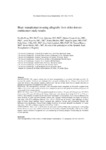Heart transplantation using allografts from older donors: multicenter study results

Ver/Abrir
Use este enlace para citar
http://hdl.handle.net/2183/17512Colecciones
- Investigación (FEP) [490]
Metadatos
Mostrar el registro completo del ítemTítulo
Heart transplantation using allografts from older donors: multicenter study resultsAutor(es)
Fecha
2014-11-14Cita bibliográfica
Roig E, Almenar L, Crespo-Leiro M, et al. Heart transplantation using allografts from older donors: multicenter study results. J Heart Lung Transplant. 2015;34(6):790-6
Resumen
[Abstract] Background. The lengthy waiting time for heart transplantation is associated with high mortality. To increase the number of donors, new strategies have emerged, including the use of hearts from donors ≥50 years old. However, this practice remains controversial. The aim of this study was to evaluate outcomes of patients receiving heart transplants from older donors.
Methods. We retrospectively analyzed 2,102 consecutive heart transplants in 8 Spanish hospitals from 1998 to 2010. Acute and overall mortality were compared in patients with grafts from donors ≥50 years old versus grafts from younger donors.
Results. There were 1,758 (84%) transplanted grafts from donors < 50 years old (Group I) and 344 (16%) from donors ≥50 years old (Group II). Group I had more male donors than Group II (71% vs 57%, p = 0.0001). The incidence of cardiovascular risk factors was higher in older donors. There were no differences in acute mortality or acute rejection episodes between the 2 groups. Global mortality was higher in Group II (rate ratio, 1.40; 95% confidence interval, 1.18–1.67; p = 0.001) than in Group I. After adjusting for donor cause of death, donor smoking history, recipient age, induction therapy, and cyclosporine therapy, the differences lost significance. Group II had a higher incidence of coronary allograft vasculopathy at 5 years (rate ratio, 1.67; 95% confidence interval, 1.22–2.27; p = 0.001).
Conclusions. There were no differences in acute and overall mortality after adjusting for confounding factors. However, there was a midterm increased risk of coronary allograft vasculopathy with the use of older donors. Careful selection of recipients and close monitoring of coronary allograft vasculopathy are warranted in these patients.
Palabras clave
Heart transplantation
Older donors
Cardiac allograft vasculopathy
HTx prognosis
Survival after HTx
Older donors
Cardiac allograft vasculopathy
HTx prognosis
Survival after HTx
Descripción
33rd Annual Meeting and Scientific Session of the International Society for Heart and Lung Transplantation, April 24–27, 2013, Montreal, Canada.





